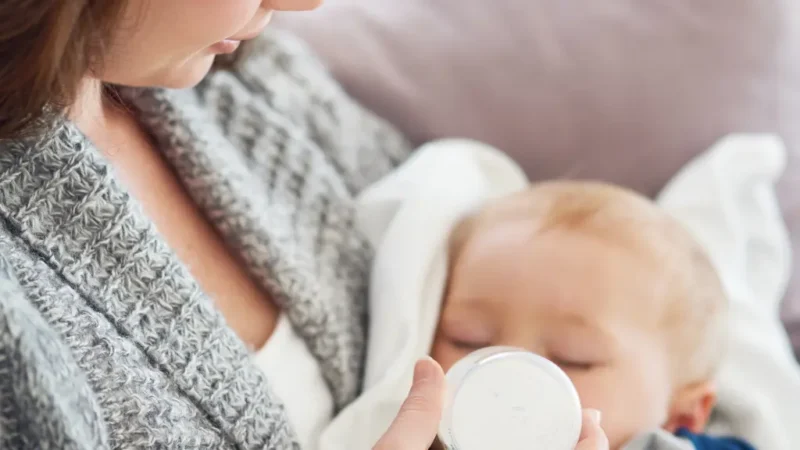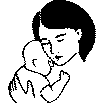When to stop contact naps – a question that puzzles many parents as their little ones reach new developmental milestones.
The cozy moments of your baby snuggled against you, both drifting off into peaceful slumber, are truly cherished. However, there comes a time when your baby is ready to transition to independent napping.
This guide will explore the telltale signs that indicate your little one’s readiness, providing tips and strategies to navigate this journey smoothly.
Embrace this milestone with open arms, for it’s a beautiful step towards your baby’s growing independence and self-soothing abilities.

When to Stop Contact Naps?
Between 9-12 months is a common age range when many babies are ready to stop contact napping and transition to independent napping in their crib or bed. At this stage, increased mobility, awareness, and developmental milestones can make it challenging for babies to stay settled during contact naps.
Benefits of Contact Napping:
Contact napping offers a multitude of benefits for both you and your baby:
- Bonding: Holding your baby close during nap time strengthens the emotional connection between you two, fostering a sense of security and trust.
- Comfort: For many babies, the warmth, heartbeat, and familiar scent of their parents can be incredibly soothing, making it easier for them to fall and stay asleep.
- Longer Nap Durations: Studies suggest that babies tend to sleep longer and more soundly during contact naps, providing them with the restorative rest they need for growth and development.
- Stress Relief: The act of cuddling and rocking your baby can trigger the release of feel-good hormones, like oxytocin, which can help reduce stress and promote relaxation for both you and your little one.
Signs Your Baby Is Ready to Stop Contact Napping
As wonderful as contact napping can be, there comes a time when your growing baby might be ready to move on to independent napping. Here are some telltale signs to watch out for:
- Rolling Over: If your once-stationary infant has become a master roller, contact napping can become a safety hazard. You don’t want your little acrobat tumbling off your lap or the couch!
- Increased Mobility: Once your baby starts crawling or trying to stand up, staying still for a contact nap becomes a major challenge. You might find yourself chasing after them more than cuddling them.
- Distraction and Fussiness: As your baby’s curiosity and awareness of their surroundings grow, they might become easily distracted during contact naps, leading to shorter and more restless sleep periods.
- Sleep Pattern Changes: If your baby starts resisting contact naps or taking shorter naps, it could be a sign that they’re ready for a change in their sleep routine.
Remember, every baby is unique, and there’s no one-size-fits-all timeline for when to stop contact napping. Trust your instincts and observe your little one’s cues.
Transitioning Away from Contact Naps
Once you’ve noticed the signs that your baby is ready to move on from contact napping, it’s time to start the transition process.
Here are some tips to make the shift as smooth as possible:
Gradual Transition Process
Rather than going cold turkey, try a gradual approach to help your baby adjust to independent napping:
- Start with One Nap: Begin by having your baby take one nap per day in their crib or bed, while still offering contact naps for the other nap times.
- Introduce a New Sleep Environment: Create a calming and comfortable sleep space for your baby, complete with soft bedding, soothing music, or white noise, and any beloved stuffed animals or blankets.
- Use Sleep Associations: Establish a consistent pre-nap routine, such as reading a book, singing a lullaby, or giving them a special lovey or pacifier to help them associate these activities with sleep.
- Stay Close, but Gradually Increase Distance: For the first few attempts at independent napping, sit or lie next to your baby’s crib or bed, gradually increasing the distance as they become more comfortable.
Alternatives to Contact Naps
If your baby is resistant to independent napping, don’t fret! There are alternative methods you can try:
- Rocking, Patting, or Holding Until Drowsy: Instead of holding your baby for the entire nap, rock, pat, or keep them until they become drowsy, then gently transfer them to their crib or bed.
- Using White Noise or Sleep Aids: Invest in a white noise machine, soothing music, or calming scents like lavender to create a relaxing sleep environment.
- Establishing a Comfortable Sleep Environment: Make sure your baby’s sleep space is cool, dark, and cozy, with soft bedding and their favorite stuffed animal or blanket.
Dealing with Resistance and Setbacks
Transitioning away from contact napping can be a bumpy road, and it’s not uncommon to encounter resistance or setbacks along the way. Here are some tips for handling these challenges:
- Be Patient and Consistent: Stick to your new nap routine, even if your baby protests at first. Consistency is critical to establishing new sleep habits.
- Offer Comfort and Support: If your baby becomes distressed during independent napping attempts, offer reassurance and comfort, but avoid reverting to contact napping. Instead, try alternative soothing techniques like rocking or patting.
- Adjust Schedules and Routines: If your baby seems overtired or overstimulated, consider adjusting their nap schedule or bedtime routine to better align with their current sleep needs.
- Seek Professional Help: If you’re struggling with persistent sleep issues or concerns, don’t hesitate to consult with a pediatrician, sleep specialist, or child development expert for personalized guidance.
Age-appropriate Nap Schedules
As your baby grows, their nap needs will evolve. Here’s a general guideline for age-appropriate nap schedules:
| Age Range | Recommended Nap Duration | Number of Naps |
|---|---|---|
| 0-3 months | 6-8 hours | As needed |
| 4-8 months | 3-4 hours | 2-3 naps |
| 9-12 months | 2-3 hours | 1-2 naps |
| 1-2 years | 1-2 hours | 1 nap |
Keep in mind that these are just general recommendations, and every baby’s sleep needs are unique. Observe your little one’s cues and adjust their nap schedule accordingly.
Self-Care for Parents
Navigating the transition away from contact napping can be emotionally and physically demanding for parents.
It’s essential to prioritize self-care during this period to avoid burnout and maintain your mental and emotional well-being.
- Ask for Support: Don’t be afraid to reach out to your partner, family members, or friends for help and emotional support during this challenging time.
- Practice Self-Compassion: Be kind to yourself and remember that every parent goes through this transition. It’s okay if it doesn’t go perfectly – you’re doing your best.
- Take Breaks: When possible, take breaks to recharge and engage in activities that bring you joy and relaxation, whether it’s reading a book, taking a bath, or going for a walk.
- Seek Professional Support: If you’re struggling with feelings of anxiety, depression, or overwhelming stress, consider seeking support from a therapist or counselor who can provide valuable coping strategies.
Conclusion
Deciding when to stop contact napping is a personal journey that every parent and baby must navigate at their own pace.
While it can be bittersweet to say goodbye to those precious snuggly nap times, the transition to independent napping is an essential step in your baby’s development.
Remember, there is no one-size-fits-all approach, and it’s perfectly normal to encounter bumps in the road. Trust your instincts, be patient, and don’t hesitate to seek support when needed.
With time, consistency, and a whole lot of love, your little one will embrace independent napping, and you’ll both embark on a new chapter of growth and independence.
So, take a deep breath, savor those final contact naps, and know that you’ve got this fantastic parent!
Your baby is on their way to becoming a nap-time champion, and you’ll always have those cherished memories of their little body nestled against yours, both lost in the blissful realm of dreamland.
What age should contact naps stop?
There is no definitive age when contact naps should stop, as it varies from baby to baby. However, most experts suggest transitioning away from contact napping between 6-12 months old as your baby becomes more mobile and aware of their surroundings. Watch for signs like rolling over, crawling, or increased distraction during naps.
How to transition from contact napping to crib?
To transition from contact napping to crib napping, it’s best to take a gradual approach. Start by putting your baby down for one nap per day in the crib while continuing contact naps for the other nap times. Establish a consistent pre-nap routine, like reading a book or singing a lullaby, to help your baby associate these activities with sleep. You can also try rocking, patting, or holding your baby until they are drowsy before transferring them to the crib. Be patient and consistent, and offer comfort and support during this transition.
